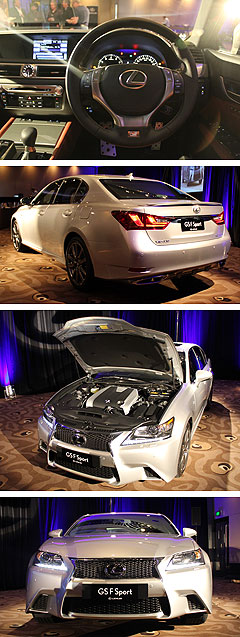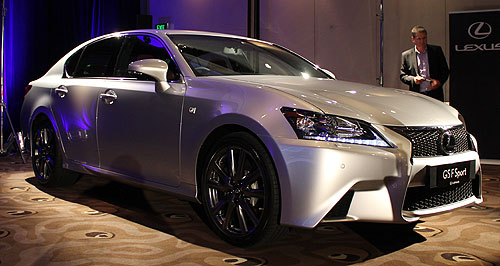Future models - Lexus - GS - F SportLexus GS F Sport races inAround the bend: The Lexus GS F Sport will will arrive in Australian showrooms late in the first quarter or early in the second quarter of next year. Aussie media among the world’s first to view impressive new Lexus GS F Sport3 Nov 2011 ONE of the world’s first unveilings of the next-generation Lexus GS luxury sedan in performance-oriented F Sport guise took place in Melbourne last night at a media event held almost simultaneously with the car’s North American public debut at the SEMA car customisation show in Las Vegas. Lexus confirmed 3.5-litre petrol V6-powered GS350 sedans – in both standard and F Sport guise – will arrive in Australian showrooms late in the first quarter or early in the second quarter of next year. They will be followed two months later by the more powerful yet more frugal GS450h petrol-electric hybrid variants that will also be available with the F Sport treatment. Trim level and pricing details were not forthcoming, nor was confirmation of mooted further variants such as a hot V10-powered GS-F or a plug-in hybrid. Asked whether prices were likely to go up, down or remain relatively static compared with the outgoing model, Lexus Australia corporate manager for product planning Greg Gardner told GoAuto the company will “aim to be very competitive” on price. The brand’s corporate manager for marketing and after-sales, Peter Evans, also suggested the hybrid variants may not continue to command the significant $20,000 price premium of its predecessor – and could even compete with volume-selling four-cylinder variants of the equivalent German cars due to the technology’s decreasing cost, citing the sharp pricing achieved for the hybrid-only CT200h premium compact.  Left: Images from last night's event in Melbourne. Left: Images from last night's event in Melbourne.Mr Evans said customers looking at the European competition who “want that kind of fuel consumption can buy a GS450h, which has 252kW – a lot more than those 2.0-litre turbo-diesels – and more combined torque”. “Hybrids have become more cost-efficient,” he added. “There is no price premium on the CT200h, which costs less than a BMW 118d same with the Audi A3.” Considering the powerful new GS450h achieves claimed fuel consumption of 6.3 litres per 100 kilometres – well below the government’s fuel-efficiency threshold for a Luxury Car Tax discount and similar to six-cylinder diesels and four-cylinder petrols from Audi, BMW and Mercedes-Benz – Australians could well see savings in the showroom as well as at the pumps. Prior to the media reveal of the F Sport, the new GS made its Australian public debut at the weekend – without the F Sport accoutrements but in hybrid 450h guise – in the Lexus marquee at Melbourne’s Flemington racecourse as part of the brand’s sponsorship of the Spring Carnival. Lexus Australia PR manager Tyson Bowen said the relatively small Australian market was able to secure one of the world’s first GS F Sport display cars because of the popularity of F Sport variants here and Australia’s world leadership in establishing the F Sport sub-brand. “F Sport has been a huge success here,” said Mr Bowen. “On the CT, F Sports are about 30 per cent of sales at the moment and, with the IS350, 48 per cent are F Sport sales. “Japan has been asking us to report back on what we’re doing with F Sport as a test bed for other markets because there are other markets that are looking to establish it.” The pre-production GS F Sport viewed by GoAuto exhibited impressive visual presence far exceeding what has so far been expressed in photos, and its styling marks a big step away from the blandness that went before, but it was the interior that made the car stand out. First impressions are that Lexus has taken a leaf out of BMW’s book with its dashboard layout, especially the sportiness, ergonomics and position of the multi-function screen, but it has also learnt from Audi how to combine textures and materials to construct a luxurious yet thoroughly modern-feeling environment. It has not gone as far as Jaguar in creating a festival of surprise and delight features to welcome the driver, but a nod to the sentiment presents itself in the form of an LED-illuminated analogue clock that goes to full brightness on first opening the door and gently dims as the occupants are about to leave. Instantly comfortable sports seats upholstered in a surprisingly classy shade of soft, supple Garnet red leather provide a luxury feel, which was extended by the fact there are few areas of exposed hard plastic, making the interior of the GS feel like it belonged to a class above. With the exception of a slightly tacky surround for the CD player, the dashboard looks and feels great and the aluminium trim panels are a pleasure to behold – as well as to touch – and the same goes for the soft leather wrapping of the steering wheel and gear selector. Shame, then, that the interior door handles of a $100,000 car are made from cheap-feeling metallic-painted plastic rather than real metal, which are found in cars costing far less. The display model’s various control knobs and switches had a satisfying weight of action and feel, similar to that found on high-end hi-fi equipment but seldom achieved by other competitors in this class. Lexus has improved the Remote Touch Interface – a joystick-like control device for the multi-function display – to make it easier to use. A leather-clad cushion supports the forearm that operates the controller but the menu system’s graphics seem clunky and dated. Even with a sunroof fitted, there was plenty of headroom and the work done by Lexus to ease entry and egress has paid off. Unfortunately, although the rear seats are just as comfortable as those in the front and headroom remains generous in the back, legroom is tighter than in some small-segment cars. Work to improve boot space has paid off, with a redesigned battery pack and related electronics helping to liberate a 45 per cent increase to 464 litres on the Hybrid while non-hybrid models get a 20 per cent increase over the old model to 532 litres. Lexus Australia chief executive Tony Cramb described the car as an “absolute game changer” that will “lead the way for a company that is on the move”. “I think that over the next couple of years you are going to see a completely different Lexus than the one you have been used to,” he said. The new GS will feature plenty of new technology aimed at improving efficiency and driving dynamics, including a body structure claimed to be 14 per cent stiffer yet 30kg lighter than the old model thanks to the increased use of laser welding, ultra high-strength steels, aluminium and hot-pressed metal. F Sport models get the same V6 petrol and hybrid powerplants as the standard cars but dynamic performance is increased by the addition of the Lexus Dynamic Handling system that combines fatter anti-roll bars and uprated suspension bushes with the standard fitment of a retuned Adaptive Variable Suspension system that is optional on the standard car. Dynamic Rear Steering – which makes the GS the first hybrid model to feature rear steer – can turn the rear wheels up to two degrees in the opposite direction to the front wheels at speeds for maneuverability below 80km/h and the same direction at higher speeds to aid stability. F Sports also get bigger, two-piece front brake discs with high-performance pads, behind unique F Sport-styled 19-inch alloy wheels. Visually, F Sport models more closely resemble the LF-Gh concept that previewed the GS, with an aggressive mesh grille and sports bodykit that features side skirts, lip spoiler, a front bumper with large air intakes and a rear diffuser flanked by huge chrome exhaust outlets.  Read moreAll future models Alfa Romeo Alfa Romeo Abarth Abarth Alpine Alpine Alpina Alpina Audi Audi Aston Martin Aston Martin BMW BMW Bentley Bentley Chery Chery Brabham Brabham Chrysler Chrysler Chevrolet Chevrolet Cupra Cupra Citroen Citroen DS DS Dodge Dodge Fiat Fiat Ferrari Ferrari Foton Foton Ford Ford Great Wall Great Wall FPV FPV Haval Haval GWM GWM Honda Honda Holden Holden Hummer Hummer HSV HSV Infiniti Infiniti Hyundai Hyundai Jaguar Jaguar Isuzu Isuzu Kia Kia Jeep Jeep Land Rover Land Rover Lamborghini Lamborghini Lexus Lexus LDV LDV Mahindra Mahindra Lotus Lotus Mazda Mazda Maserati Maserati Mercedes-AMG Mercedes-AMG McLaren McLaren MG MG Mercedes-Benz Mercedes-Benz Mitsubishi Mitsubishi Mini Mini Opel Opel Nissan Nissan Peugeot Peugeot Pagani Pagani Proton Proton Porsche Porsche Renault Renault Ram Ram Rover Rover Rolls-Royce Rolls-Royce Skoda Skoda Saab Saab SsangYong SsangYong Smart Smart Suzuki Suzuki Subaru Subaru Toyota Toyota Tesla Tesla Volvo VolvoGS pricing
Motor industry news |
Click to shareLexus modelsResearch Lexus All future models Alfa Romeo Alfa Romeo Abarth Abarth Alpine Alpine Alpina Alpina Audi Audi Aston Martin Aston Martin BMW BMW Bentley Bentley Chery Chery Brabham Brabham Chrysler Chrysler Chevrolet Chevrolet Cupra Cupra Citroen Citroen DS DS Dodge Dodge Fiat Fiat Ferrari Ferrari Foton Foton Ford Ford Great Wall Great Wall FPV FPV Haval Haval GWM GWM Honda Honda Holden Holden Hummer Hummer HSV HSV Infiniti Infiniti Hyundai Hyundai Jaguar Jaguar Isuzu Isuzu Kia Kia Jeep Jeep Land Rover Land Rover Lamborghini Lamborghini Lexus Lexus LDV LDV Mahindra Mahindra Lotus Lotus Mazda Mazda Maserati Maserati Mercedes-AMG Mercedes-AMG McLaren McLaren MG MG Mercedes-Benz Mercedes-Benz Mitsubishi Mitsubishi Mini Mini Opel Opel Nissan Nissan Peugeot Peugeot Pagani Pagani Proton Proton Porsche Porsche Renault Renault Ram Ram Rover Rover Rolls-Royce Rolls-Royce Skoda Skoda Saab Saab SsangYong SsangYong Smart Smart Suzuki Suzuki Subaru Subaru Toyota Toyota Tesla Tesla Volvo VolvoGS pricing
Motor industry news |















Facebook Twitter Instagram